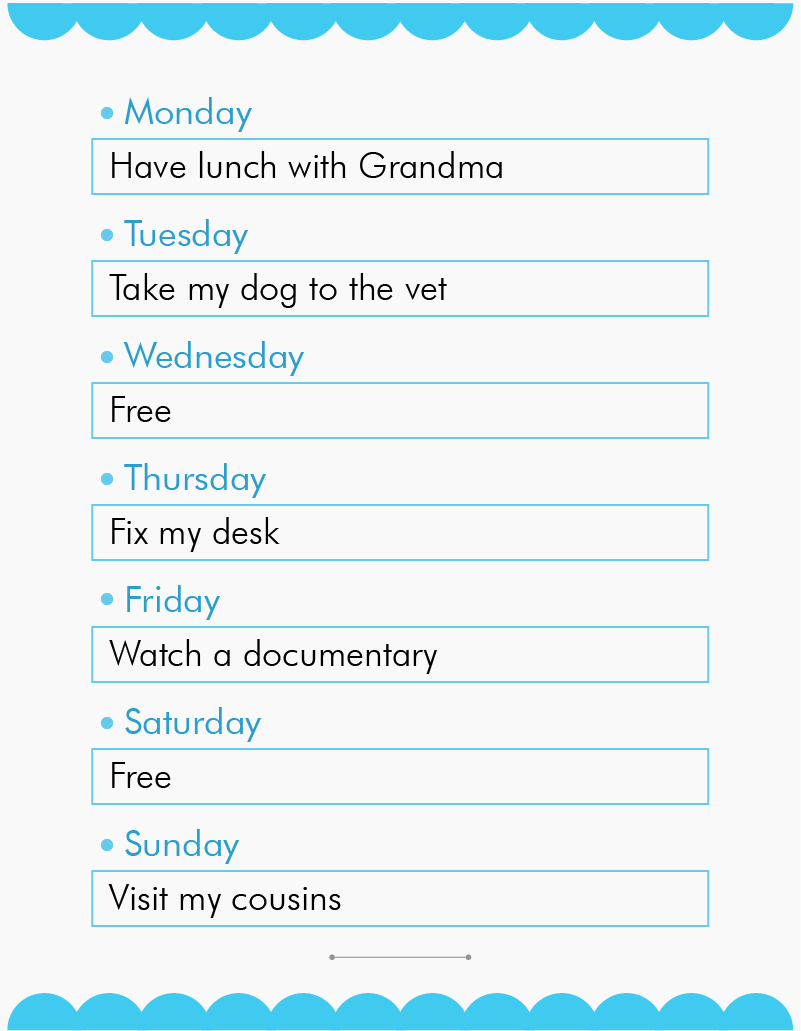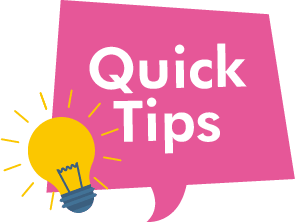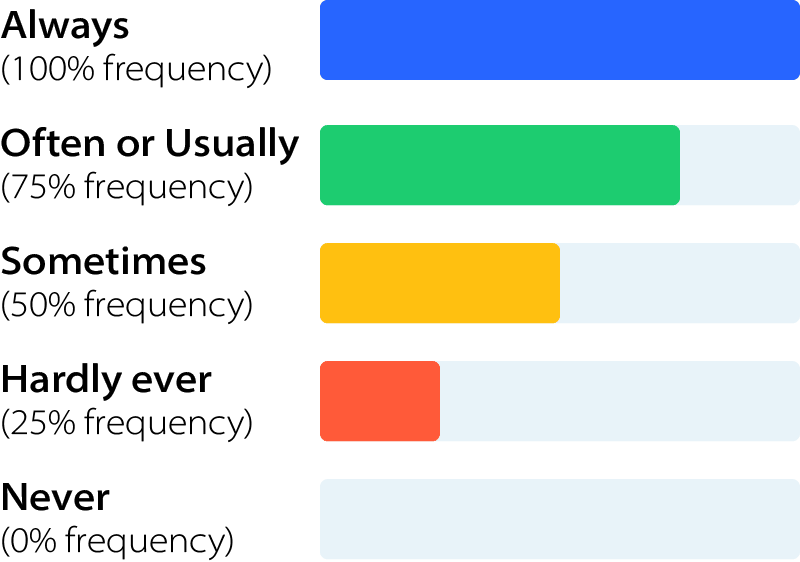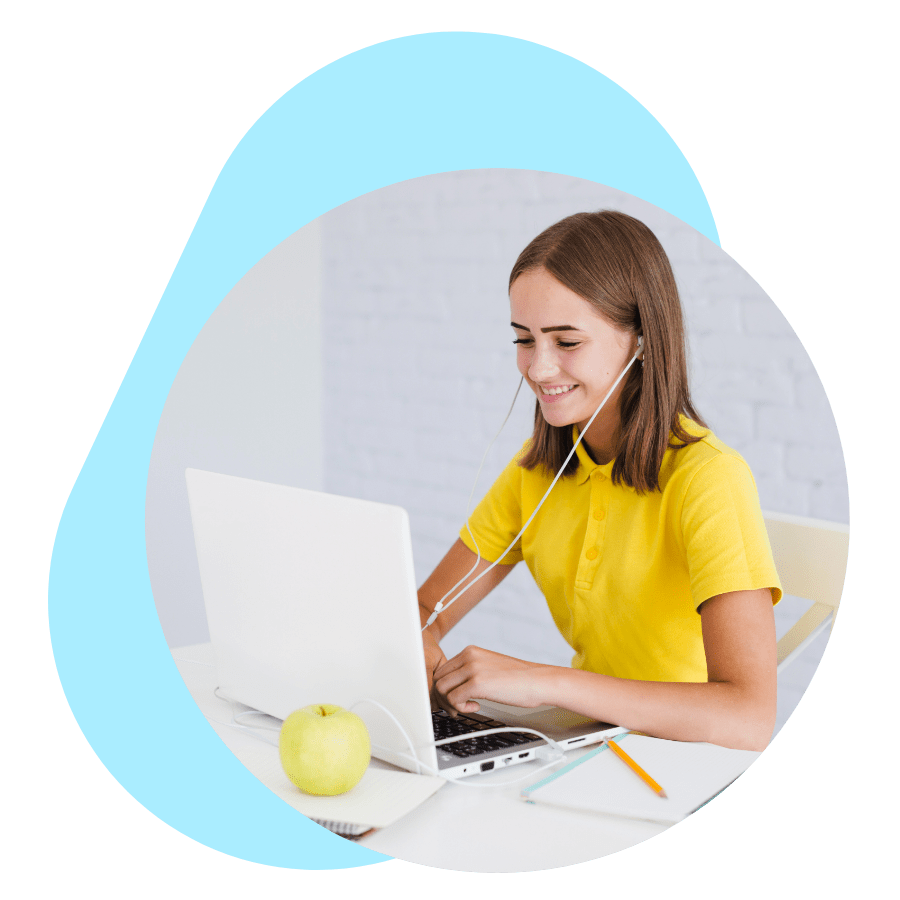1- Talking about routines & habits
Telling mine, and other’s routines.
1.1- Activities
This is a list of activities people do every day:
- Wake up
- Get up
- Take a shower
- Get dressed
- Brush (your) teeth
- Have breakfast
- Go to school / go to work
- Hang out with friends
- Have a snack
- Have lunch
- Leave work/school
- Watch movies / Netflix
- Go to a friend’s birthday party
- Scroll on social media
- Post on social networks
- Play video games/ online
- Do exercises
- Go shopping
- Spend time with (your) family
- Go to bed
1.2- Giving positive information about routines
To talk about daily routines, you have to think about the activities you do during a week. What activities are important in your life?
Let’s see mine:

| My name is Sebastian and this is my routine: I wake up everyday at 6 am. I sometimes watch the news and then I have breakfast. I love a good coffee and some avocado toasts in the morning. Then I go to work. I leave work at around 5 pm. At home, I spend time with my family for two hours every day. After I watch Netflix with my kids, I go to bed. |
Did you notice? To say my routine I only used some of the activities in the list above to start telling information. This is how it works.
First I use the word ‘I’ (yo) to refer to myself, and then I add the activity, with no modifications.
Example:
I watch Netflix, I hang out with friends, I read a book.
The same happens when you, we, or they, talk about their routines. We only need to add the activity next to the person.
Example:
You go shopping, We have lunch at 2 pm, They play video games online
Things change when you want to talk about he, she, or it. Pay attention to this.
Everytime we have he, she, or it as the subjects of a sentence. We need to modify the activity (verb) by adding a sound with ‘s’ at the end of each verb. These endings can be -s , -ies , -es , -ss. The modification of the verbs depend on the following:
1. We add -s to most verbs, in the case of verbs ending in -y, we only add the -s if the letter that comes before -y is a vowel:
Lilian spends time with her family everyday.
Marshall gets up everyday at 7 am.
My brother plays video games only on weekends.
2. We add -ies to the verbs that finish in -y, and the letter that comes before -y is a consonant. We do a different process here. We eliminate de -y before we add -ies
My dad tryies a new hobby every month 
My dad tries a new hobby every month 
3. We add -es to verbs finishing in -o,-x,-ch,-sh, -zz.
Sophie goes to school every week from Monday to Friday
Dad fixes his car every time it has problems
Mom watches TV in the mornings, before work
Tom washes his school uniform every weekend
Leo buzzes (stops) his alarm every ten minutes. He’s always late!
4. We change have for has. Have is "irregular" so the rules are different. We need to memorize using ‘has’ with he, she, or it.
Sarah has lunch at school, but John has lunch at home.
Not so clear? Let’s have a look at a girl’s agenda. An agenda helps organize our time:
Lu’s agenda

Lu is a 13 year old girl. She is a very energetic girl and has many activities daily. Let’s see what her agenda looks like for this week.

Lu is a girl, so her subject is "she". If we want to describe Lu’s agenda we need to modify all the verbs according to the rules we learned above.
On Monday, Lu has lunch with grandma
On Tuesday, She takes her dog to the vet
On Thursday, She fixes her desk
On Friday, she watches a documentary
On Sunday, she visits her cousins.

Spanish corner:
Para expresar hábitos y rutinas tenemos dos reglas que seguir. La primera es que al utilizar sujetos como "I, you, we, they" (Yo, tú, nosotros, ellos) solamente usamos la actividad y no hacemos modificaciones. Solo seguimos la siguiente estructura: sujeto + verbo sin modificaciones + detalles. La segunda regla es que, si queremos utilizar sujetos como "he, she, o it" (él, ella, o esto – refiriéndose a cualquier sujeto no humano; una cosa o un animal) debemos seguir la siguiente estructura sujeto + verbo con modificaciones + detalles. Las modificaciones se especifican arriba con los colores correspondientes.
1.3- Giving negative information about routines
Giving negative information about routines is totally different from giving positive information. For giving negative information, we need some help. This help comes in the form of auxiliaries. Auxiliaries for giving negative information about routines are don’t (do not), and doesn’t (does not).
We use "don’t" with I, you, we, they. Below you’ll find some examples:
I don’t have breakfast in the mornings. I prefer a snack.
My friends don’t play games online, they prefer board games.
My family and I don’t watch TV before bed.
We use "doesn’t" with he, she, and it. Below you’ll find some examples.
Grace doesn’t leave school early. She waits for her dad. He’s a teacher.
Frank doesn’t post on social networks. He prefers face to face interactions.
My dog doesn’t go to bed with me. My dog has a dog bed.
Don’t and doesn’t help us tell information about routines. This means that we don’t need to add any modification to the verbs in the presence of auxiliaries "don’t", and "doesn’t". So, the actions don’t need any modifications.
Grace doesn’t leaves school early. She waits for her dad. He’s a teacher. 
Grace doesn’t leave school early. She waits for her dad. He’s a teacher. 

Spanish corner:
Para expresar negaciones acerca de rutinas necesitamos de los auxiliares "don’t" y "doesn’t". Utilizamos don’t con I, you, we, they (yo, tú, nosotros, ellos). Utilizamos doesn’t con he, she, it (él, ella, esto -no humano). Los auxiliares tienen mucha importancia, estos indican que estamos negando información, ya añaden una característica especial a la oración, por lo tanto, no necesitamos modificar los verbos de las oraciones con ‘he, she, it’ como en las oraciones positivas. La estructura para oraciones negativas es: sujeto + don’t o doesn’t + verbo sin modificaciones + complemento.
2- Telling how frequent is your routine
Using words of frequency and time is very important to give more information about your routine. Have a look at these examples from Robert.

|
I always have breakfast in the mornings. It’s the most important food of the day. I go to school from Monday through Friday and I sometimes play videogames online after school. I often go to see my cousins, we live really close. I never go to the cinema, I prefer to see friends. I hardly ever go shopping, I think it’s boring. Every summer, my family and I go to the beach. We love the sea. |
The colored words indicate a word of frequency (light blue) or a phrase of time (orange). These are useful for specifying how frequently and action happens or when an action happens.
First, let’s have a look at words of time:
|
Phrases of time |
On Monday, On Tuesday, On Wednesday, On Thursday, On Friday |
|
Everyday, Every (specific day), Every (month), Every (season) |
Phrases of time go at the beginning or at the end of a sentence:
On Wednesday, George goes to work. He is a tutor.
Every June, Lisa plans her birthday for July.
We visit my grandma in the countryside every spring.
Now, let’s have a look at phrases of frequency.

Words of frequency go after the subject of the sentence, but before the verb with the necessary modifications.
Craig often scrolls on social media. His favorite is Instagram.
Robert hardly ever goes shopping. He thinks shopping is boring!
My friends and I never play videogames. We usually watch Netflix.

Spanish corner:
Para referirnos a la frecuencia en la que hacemos una actividad de rutina, o el tiempo en la que la realizamos, utilizamos frases de tiempo (días, meses, estaciones, años, horas) o palabras de frecuencia (siempre, usualmente, a veces, casi nunca, nunca. Las frases de tiempo pueden ir al principio o al final de la oración, mientras que las palabras de frecuencia solo pueden ir luego del sujeto y antes del verbo en una oración).
3- Making conversation about routines: Asking questions
Let’s read a conversation between Lu and Robert.

Lu: Hello, Robert. How often do you go to swimming lessons?
Robert: Hi Lu, I go to swimming lessons every Wednesday. Do you go to swimming lessons?
Lu: No, I don’t. I don’t like swimming. I’m scared of the water. Where do you go for your lessons?
Robert: Oh, that’s a bummer! I have my lessons in the local swimming pool.
Lu: Sounds fun! What do you usually eat for breakfast?
Robert: It is really fun. I often eat eggs and toasts for breakfast. I sometimes eat some fruit, but I don’t have time everyday. When do you usually go to dance school?
Lu: I often go to the theater in the center of the city. The theater is a famous dance school! Where does your sister go for dance school?
As you can see, we need some important words to make questions about people’s routines. We need question words and question auxiliaries do and does.
First, let’s have a look at question words:
How often  We use this question word to know the frequency of an activity.
We use this question word to know the frequency of an activity.
How often do you see movies with your family?
How often does your mom go shopping?
Where  We use this question word to know the place an activity happens
We use this question word to know the place an activity happens
Where do your friends play online?
Where does Elena go to her friend’s birthday party
When  We use this question word to know the time an activity happens
We use this question word to know the time an activity happens
When do you usually go to see movies?
When does your dad leave work?
What  We use this question word to know the activity happening or the things involved in the activity.
We use this question word to know the activity happening or the things involved in the activity.
What do you usually have for lunch?
What does your cousin see on TV?
Now, let’s have a look at questions auxiliaries do and does.
|
Do |
Does |
|
We use "do" when the subjects of the question are: I, you, we, or they. |
We use "does" when the subjects of the question are he, she, or it. |
|
Do you usually see your family in the afternoon? Do your parents watch a lot of TV? Do you and your friends play online a lot? |
Does Peggy leave school on time? Does your friend have snacks during the day? Does the cat play with you? |
In conclusion, we see that the structure for asking questions is:
(Question Word) Do or Does + Subject + Verb with no modification + details

